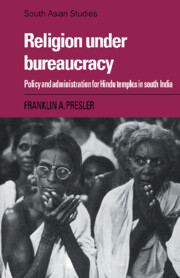Book contents
- Frontmatter
- Contents
- Dedication
- Preface
- Notes on sources, abbreviations and transliteration
- Map
- 1 Introduction: studying religion-state relations
- 2 The temple connection in the nineteenth century
- 3 Governance: the necessity for order
- 4 Governance: trustees and the courts
- 5 Economy: the problem of controlling land
- 6 Economy: the temple's weakness as landlord
- 7 Religion: purifying and organizing Hinduism
- 8 Religion: controlling the priesthood
- 9 Conclusion
- Bibliography
- Index
8 - Religion: controlling the priesthood
Published online by Cambridge University Press: 03 October 2009
- Frontmatter
- Contents
- Dedication
- Preface
- Notes on sources, abbreviations and transliteration
- Map
- 1 Introduction: studying religion-state relations
- 2 The temple connection in the nineteenth century
- 3 Governance: the necessity for order
- 4 Governance: trustees and the courts
- 5 Economy: the problem of controlling land
- 6 Economy: the temple's weakness as landlord
- 7 Religion: purifying and organizing Hinduism
- 8 Religion: controlling the priesthood
- 9 Conclusion
- Bibliography
- Index
Summary
From the beginning of its administration, the HRCE has made temple priests a target of its administrative efforts. Not that priests have ever posed a threat to overall HRCE control, as have trustees, the courts and the BOR, or even that priests play a particularly large role in temple economy and governance. The HRCE's focus on priests derives from its definition of the temple as fundamentally religious and public. It believes that the priest is the temple's central functionary and that his activities, more than those of anyone else, define the core of the institution. The care or lack of care with which priests conduct daily pujas, periodic festivals and other rituals, such as marriages and archanais, is seen as a critical index of the temple's overall health.
What have been the effects of HRCE administration on the position and status of priests? Is there any general pattern in the way their interests have been affected over a half century of HRCE administration? How have the priests represented and defended their interests? Have they been able effectively to oppose threatening policies? These questions inevitably raise the issue of India as a secular state. The last chapter suggested that high stateness gives the HRCE considerable latitude. Are there any limits, self-imposed or constitutional, to the control the HRCE exerts over the temple priest, the functionary whom the department itself acknowledges to be preeminently religious?
These questions are explored in this chapter. The answers are complicated, and will require attention both to constitutional questions and to the temple priest's status in Hindu society.
- Type
- Chapter
- Information
- Religion under BureaucracyPolicy and Administration for Hindu Temples in South India, pp. 134 - 154Publisher: Cambridge University PressPrint publication year: 1988



